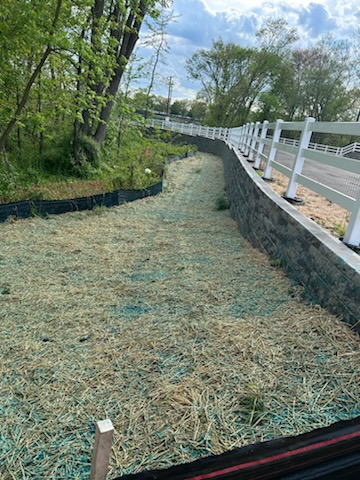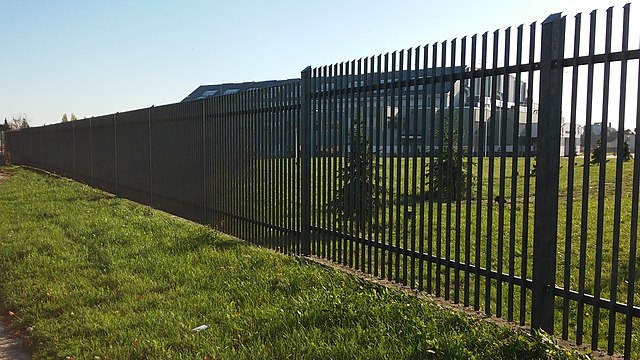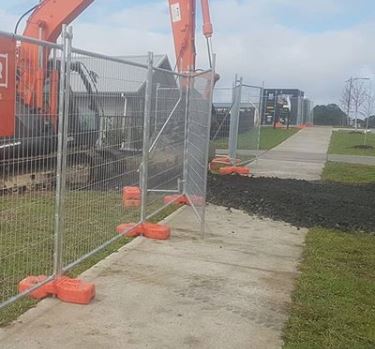
In New Jersey construction and land management, controlling soil erosion and sediment is important for maintaining the integrity of any project.
One of the most effective erosion control strategies is the use of vegetation and reseeding bare areas. Bare soil is highly susceptible to erosion, where flowing water washes away material from the surface of the soil. This degrades the soil surface and leads to costly damages and regulatory challenges.
By establishing a robust vegetative cover, stakeholders such as owner-builders, corporations, and real estate developers can significantly enhance their erosion control efforts.
When is the best time to hydroseed?
In NJ, both fall and spring are great times to hydroseed your lawn. Hydroseeding in spring is beneficial because of the moderate temperatures. Late summer/early fall is optimal, as the temperatures continue to fall and the precipitation increases. The spring and fall allow for faster growth than in cold and hot seasons, but won’t require as much water as a lawn that began in the drier summer season.
Understanding Erosion and Sediment Control
Erosion and sediment control is part of managing land and construction projects and involves strategies designed to prevent soil particles from being dislodged and transported by wind or water. Unchecked erosion can lead to significant environmental and economic impacts including the loss of valuable topsoil, leading to barren, bare soil surfaces that are prone to further degradation. This process can result in rill erosion, where small channels form on the landscape, further accelerating soil loss.
Erosion and sedimentation caused by stormwater runoff causes significant environmental impact and leads to sediment accumulation in waterways, harming aquatic habitats and reducing water quality. Economically, the loss of fertile soil can diminish agricultural productivity, increase costs for land restoration, and impose regulatory fines on non-compliant stakeholders.
In New Jersey, regulatory requirements for erosion control reflect both local and federal mandates. These regulations necessitate the implementation of effective erosion control measures, such as permanent seeding, to stabilize soil surfaces and prevent erosion. Compliance is essential for various stakeholders, including construction companies, real estate developers, and homeowner associations, as it mitigates the risk of environmental damage and ensures sustainable development practices. Understanding and adhering to these regulations not only protect the environment but also safeguard the financial and operational interests of those involved in land management and construction.
The Role of Vegetation in Erosion Control
At Eastcoast Site Work, we understand how important plants are in keeping soil from washing or blowing away. Plants act like a natural shield, thanks to their roots holding the soil together. This helps stop erosion, which is why both temporary and permanent plants are vital in keeping the ground stable.
Plants also help manage water. They soak up rainwater, which cuts down on how much water runs off the surface and takes soil with it. This soaking action helps keep our natural resources in balance and stops the soil from wearing down. Quick-growing seeds can cover bare soil fast, giving protection while long-term plants take root.
Beyond erosion control, vegetation offers biodiversity benefits by enhancing local ecosystems. Strategic planting not only stabilizes soil but also creates habitats, supporting a variety of wildlife and promoting ecological diversity. Existing vegetation, when preserved and integrated into new landscaping plans, can further bolster biodiversity, contributing to a healthier environment overall. Thus, incorporating vegetation into land management practices not only safeguards the soil but also enriches the natural landscape, yielding long-term ecological and economic benefits.

The Process of Reseeding Bare Areas
Reseeding bare areas is an essential step in effective erosion control, aiming to restore vegetative cover and stabilize the soil. The process begins with a thorough site assessment to determine the extent of bare areas and identify specific erosion control systems that may already be in place. This assessment helps in planning the necessary steps for soil preparation, which typically includes tilling to break up compacted soils, fertilizing to provide essential nutrients, and amending the soil to improve its structure and fertility.
Choosing the right seed mix is important for successful reseeding. It involves selecting seeds that are well-suited to the specific environment and soil type. Native species are often preferred for their adaptability and ecological benefits, such as supporting local wildlife and requiring less maintenance. However, non-native species can also be beneficial in certain situations, offering rapid growth and ground coverage. When considering seed mixes, it’s important to balance these options to meet both ecological and project-specific goals.
The application of seeds can be carried out using various techniques, each suited to different conditions and objectives. Broadcast seeding is a simple method ideal for large areas, while hydroseeding combines seed, water, and mulch in a single application, making it effective for steep slopes and difficult terrains. Drill seeding, on the other hand, places seeds directly into the soil, providing excellent seed-to-soil contact. Best practices for these methods include ensuring even distribution and coverage to maximize germination and growth, integrating them with other erosion control measures where necessary.
Maintenance and Monitoring
Proper maintenance and monitoring are crucial for the success of reseeded areas, ensuring that the vegetation thrives and effectively controls erosion.
Initial Watering and Care
Newly seeded areas require diligent care, starting with appropriate watering guidelines. It’s important to keep the soil consistently moist, but not waterlogged, to promote seed germination and root establishment. Early morning or late afternoon watering can prevent evaporation and ensure deeper soil penetration. Protecting seeds from pests like birds and insects, as well as environmental stressors such as heavy rainfall or extreme temperatures, is essential. This can be achieved through the use of protective mulches or netting.
Long-term Maintenance
As the vegetation begins to establish, long-term maintenance becomes vital. Regular mowing helps maintain the appropriate height of grass and prevents weed dominance, while periodic fertilizing supplies essential nutrients that support healthy growth. Additional seeding might be necessary in areas where germination was sparse. Ongoing monitoring is also crucial to detect any signs of erosion or stress in the vegetation. This proactive approach allows for timely interventions, ensuring the vegetative cover remains robust and effective in erosion control.
Inspection and Documentation
Regular inspections are fundamental to evaluating the success of reseeding efforts and ensuring compliance with environmental standards. These inspections should focus on the health of the vegetation, the presence of erosion, and the effectiveness of the erosion control strategies in place.
Maintaining detailed records of reseeding efforts, including the types of seeds used, the growth progress, and any maintenance activities performed, is essential for accountability and future planning. These records provide valuable insights into the effectiveness of the methods used and can guide adjustments to improve future projects.
Application Examples
Reseeding is a versatile and effective solution for erosion control across various settings, providing both environmental and economic benefits.
Commercial and Industrial Projects
In commercial and industrial settings, reseeding plays a crucial role in stabilizing soil and enhancing landscapes, which can significantly impact project timelines and costs. By establishing a vegetative cover, companies can prevent soil erosion and sedimentation, which are common challenges in large-scale developments.

This not only helps in meeting regulatory requirements but also minimizes delays caused by environmental compliance issues. Moreover, the integration of reseeding with other erosion control systems can lead to more sustainable environmental outcomes, fostering a balance between development and ecological preservation.
Residential and Community Projects
For residential areas, particularly those managed by homeowner associations or involved in real estate developments, reseeding offers substantial benefits. It enhances community aesthetics by creating lush green spaces, which can elevate property values and attract potential buyers.
In addition, a well-maintained vegetative cover can improve stormwater management and reduce runoff, contributing to a healthier, more attractive living environment. This approach, often combined with other erosion control systems, ensures long-term stability and visual appeal of the community’s landscape.
Municipal and Public Works Projects
Municipalities can leverage reseeding as a cost-effective strategy for managing public lands. By implementing reseeding projects on road embankments, parks, and other public spaces, municipalities can reduce maintenance costs and extend the lifespan of infrastructure. The establishment of robust vegetative cover not only prevents erosion but also improves the overall quality of public spaces, providing aesthetic and recreational benefits to the community. Additionally, integrating reseeding with other erosion control systems can enhance the resilience of public lands against environmental challenges, ensuring their sustainability for future generations.
The Importance of Sustainable Erosion Control
Implementing reseeding as a sustainable erosion control measure offers numerous environmental, economic, and community benefits. By establishing a healthy vegetative cover, we can protect the soil, enhance landscapes, and comply with regulatory standards. Whether it’s for commercial, industrial, residential, or municipal projects, reseeding provides a cost-effective and efficient solution to combat soil erosion. Long-term maintenance and diligent monitoring ensure the success of these efforts, promoting ecological balance and long-lasting landscape stability.
As we move forward, adopting and refining these practices will be crucial in maintaining the integrity of our environments and the well-being of our communities.



